Second World War
On 29 September 1938, Thomas was recalled to active duty, and joined the crew of the battleship HMS Rodney. On 13 August 1939, he joined the cruiser HMS York, where he was serving when the Second World War broke out. He was promoted to commander on 27 June 1940. After it was sunk by the Italians in the Raid on Souda Bay, he was assigned to HMS Nile, the Royal Navy shore establishment in Egypt, and served on the staff of the Commander-in-Chief, Mediterranean Fleet. [2] He married a second time on 10 September 1941, to Mary Fedora Douglas-Watson, a pianist and composer. She was the widow of a fellow naval officer, Commander Francis Douglas-Watson, and the daughter of former Australian senator Anthony St Ledger. [2] [3]
Thomas became the Naval Officer in Charge (NOIC) in Tripoli on 1 March 1943, and HMS Hasdrubal (the naval base at Bizerta) on 1 July 1943. [2] He participated in the Allied Invasion of Sicily, for which he was mentioned in despatches. [4] He became the NOIC at Taranto in Italy on 9 September 1943. He returned to the UK in February 1944, and became the NOIC on the Isle of Wight, with the acting rank of captain. [2] He earned a second mention in despatches for his role in Operation Overlord, the Allied invasion of Normandy, [5] during which he served as NOIC of Port-en-Bessin, the main petroleum port for the Allied forces. [2] For his "skill, resource and organisation in the opening-up of Port-en-Bessin", [6] he was made an Officer of the Order of the British Empire on 9 March 1945. [6] From September 1944 until 22 October 1945, he was the NOIC of Antwerp in Belgium, the largest port serving the Allied forces. [2]
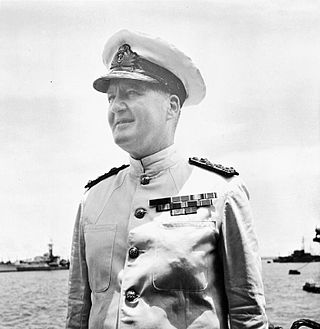
Admiral of the Fleet Bruce Austin Fraser, 1st Baron Fraser of North Cape, was a senior Royal Navy officer. He served in the First World War, saw action during the Gallipoli Campaign and took part in the internment of the German High Seas Fleet at the end of the war. He also served in the Second World War initially as Third Sea Lord and Controller of the Navy and then as second-in-command and afterwards as commander of the Home Fleet, leading the force that destroyed the German battleship Scharnhorst. He went on to be First Sea Lord and Chief of the Naval Staff in which role he assisted in establishing NATO and agreed to the principle that the Supreme Allied Commander Atlantic should be an American admiral, in the face of fierce British opposition.

Ian Edward Fraser, was an English diving pioneer, sailor and recipient of the Victoria Cross, the highest award for gallantry in the face of the enemy that can be awarded to British and Commonwealth forces. Fraser was born in Ealing in Middlesex and went to school in High Wycombe. After initially working on merchant ships and serving in the Royal Naval Reserve, he joined the Royal Navy at the start of the Second World War. After being awarded the Distinguished Service Cross for actions while serving on submarines, he was placed in command of a midget submarine during an attack in Singapore codenamed Operation Struggle. For his bravery in navigating the mined waters, and successfully placing mines on a Japanese cruiser, Fraser was awarded the Victoria Cross.
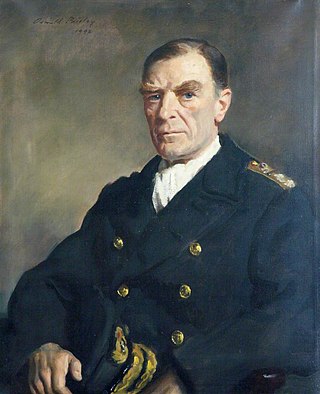
Admiral of the Fleet Sir Philip Louis Vian, & Two Bars was a Royal Navy officer who served in both World Wars.
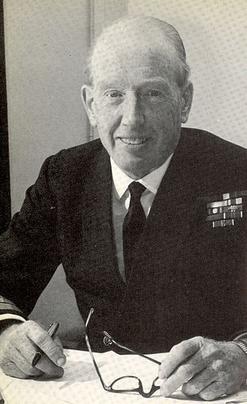
Admiral of the Fleet Sir Michael Le Fanu was a Royal Navy officer. He fought in the Second World War as gunnery officer in a cruiser operating in the Home Fleet during the Norwegian campaign and the Battle of the Mediterranean and then as gunnery officer in a battleship operating in the Eastern Fleet before becoming liaison officer between the British Pacific Fleet and the United States Third Fleet. After the War he commanded a frigate, a training establishment and an aircraft carrier. He served as First Sea Lord and Chief of the Naval Staff in the late 1960s. In that role, in the face of economic difficulties, he worked hard to reshape the Navy as an anti-submarine force operating primarily in the Atlantic Ocean.
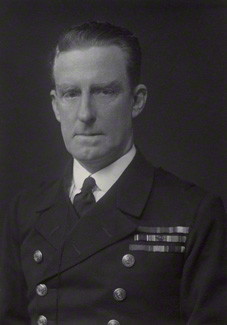
Admiral of the Fleet William Henry Dudley Boyle, 12th Earl of Cork and 12th Earl of Orrery, was a British Royal Navy officer and peer. He served as a junior officer on the China Station during the Boxer Rebellion and went on to serve in the First World War initially as a staff officer during the Dardanelles Campaign and as then commander of the Red Sea Patrol: in that capacity, he led a six-day bombardment of the Turkish held port of Jeddah and worked closely with T. E. Lawrence in support of the Arab Revolt. In the inter-war years he was Commander-in-Chief, Reserve Fleet, President of the Royal Naval College, Greenwich and Commander-in-Chief of the Home Fleet. After succeeding a cousin and becoming Earl of Cork in 1934, he became Commander-in-Chief, Portsmouth.
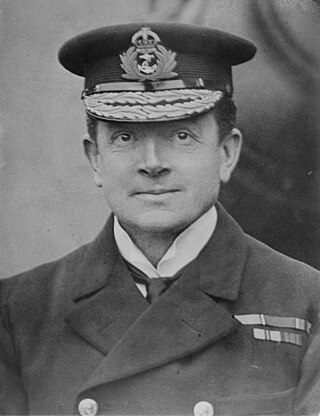
Admiral of the Fleet Sir Somerset Arthur Gough-Calthorpe, sometimes known as Sir Somerset Calthorpe, was a Royal Navy officer and a member of the Gough-Calthorpe family. After serving as a junior officer during the Fourth Anglo-Ashanti War, he became naval attaché observing the actions of the Imperial Russian Navy during the Russo-Japanese War and then went on to command an armoured cruiser and then a battleship during the early years of the 20th century.
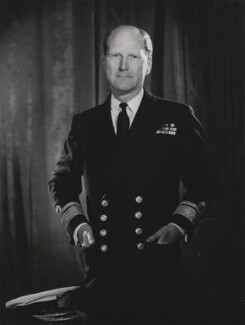
Admiral of the Fleet Sir Michael Patrick Pollock, was a senior officer in the Royal Navy who rose to become First Sea Lord and Chief of the Naval Staff in the early 1970s. In the Second World War, he was an officer on ships tasked with protecting convoys in the Atlantic and the Mediterranean, and was gunnery officer on the cruiser HMS Norfolk when she fought the German battleship Scharnhorst during the Battle of North Cape. He later commanded the aircraft carrier HMS Ark Royal, and hosted Ian Smith on HMS Tiger. In retirement, he held the position of King of Arms of the Order of the Bath and Gloucester King of Arms, with responsibility for heraldry in Wales.

Admiral of the Fleet Sir John Henry Dacres Cunningham was a Royal Navy officer. A qualified senior navigator, he became Director of Plans at the Admiralty in 1930. He saw action as Commander-in-Chief of the Mediterranean Fleet during the Second World War with responsibility for the allied landings at Anzio and in the south of France. He served as First Sea Lord in the late 1940s: his focus was on implementing the Government's policy of scrapping many serviceable ships.

Admiral Sir John David Luce, was a Royal Navy officer. He fought in the Second World War as a submarine commander before taking part in the Dieppe Raid and becoming Chief Staff Officer to the Naval Forces for the Normandy landings. He also commanded a cruiser during the Korean War. He served as First Sea Lord and Chief of the Naval Staff in the mid-1960s and in that role resigned from the Royal Navy along with Navy Minister Christopher Mayhew in March 1966 in protest over the decision by the Labour Secretary of State for Defence, Denis Healey, to cancel the CVA-01 aircraft carrier programme.

Admiral of the Fleet Sir Arthur John Power, was a Royal Navy officer. He took part in the First World War as a gunnery officer and saw action in the Dardanelles campaign. During the inter-war years he commanded the gunnery school at HMS Excellent and then the aircraft carrier HMS Ark Royal. During the Second World War he played a leading role in the planning for the Allied invasion of Sicily and for the Allied invasion of Italy and then commanded the naval forces for the actual landing of V Corps at Taranto in Italy in September 1943. He went on to be Commander-in-Chief of the East Indies Fleet in the closing stages of the war and conducted naval strikes on the Imperial Japanese Army in Borneo and Malaya. After the War he became Second Sea Lord and Chief of Naval Personnel, Commander-in-Chief, Mediterranean Fleet and then Commander-in-Chief, Portsmouth.

Admiral of the Fleet Sir Algernon Usborne Willis was a Royal Navy officer. He served in the First World War and saw action at the Battle of Jutland in May 1916. He also served in the Second World War as Commander-in-Chief, South Atlantic in which capacity he led actions against German and Japanese raiding ships. He continued his war service as Flag Officer commanding 3rd Battle Squadron and Second in command of the Eastern Fleet and then as Flag Officer commanding Force H, the force which covered North African Operations, the Allied invasion of Sicily in July 1943 and then the Allied invasion of Italy in September 1943. He spent the final years of the war as Commander-in-Chief, Levant, in which capacity he conducted naval operations in support of the Dodecanese Campaign, and then as Second Sea Lord, in which capacity he arranged the manpower for the campaign in the Pacific Ocean against the Imperial Japanese Navy. After the war he served as Commander-in-Chief, Mediterranean Fleet, in which role he was faced with unrest in Mandatory Palestine, before he became Commander-in-Chief, Portsmouth.

Vice Admiral Sir Peter William Gretton was an officer in the Royal Navy. He was active in the Battle of the Atlantic during the Second World War, and was a successful convoy escort commander. He eventually rose to become Fifth Sea Lord and retired as a vice admiral before entering university life as a bursar and academic.

Admiral Sir Albert Percy Addison, was a senior officer in the Royal Navy. He was the Rear Admiral Commanding His Majesty's Australian Fleet from 30 April 1922 to 30 April 1924. During the First World War he was recognised by the British Admiralty as an authority on submarines, and his knowledge of that class of ship was used extensively.
Rear Admiral Hugh Richard Marrack was a submarine specialist serving in the British Royal Navy, who commanded both the Portland and China Submarine flotillas and was Commodore Superintendent, Gibraltar, 1943–45. Marrack later became an ADC to King George VI.

Admiral Sir Charles Thomas Mark Pizey was a Royal Navy officer who served as the last Commander-in-Chief and first Chief of Naval Staff of the Indian Navy from 1951 to 1955.

Admiral of the Fleet Sir George Elvey Creasy, was a senior Royal Navy officer. After serving as a junior officer in the First World War, during which he took part in operations at Heligoland Bight in 1917, he trained as a torpedo officer.
Admiral Sir Geoffrey John Audley Miles, KCB, KCSI was a senior Royal Navy admiral who served as Deputy Naval Commander, South East Asia Command under Lord Mountbatten during the Second World War, as the Senior British Representative on the Tripartite Naval Commission and as the last Commander-in-Chief, Indian Navy of the unified Royal Indian Navy.
William James Lanyon Smith was a New Zealand naval officer. He served in the Royal New Zealand Naval Volunteer Reserve during World War II and was second-in-command of a midget submarine during an attack in Singapore codenamed Operation Struggle, for which he was appointed a Companion of the Distinguished Service Order.
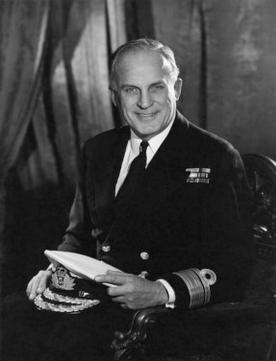
Vice Admiral Sir Hugh Martell, was a Royal Navy officer who served as Admiral Commanding, Reserves. He is best known for his part as commander of Task Force 308 in Operation Mosaic, the series of British nuclear tests in the Monte Bello Islands in Western Australia in 1956.

Captain John Fenwick Hutchings, was a British Royal Navy officer who served in the First and Second World Wars. During the latter, he commanded Operation Pluto, the project to construct submarine oil pipelines under the English Channel.

















